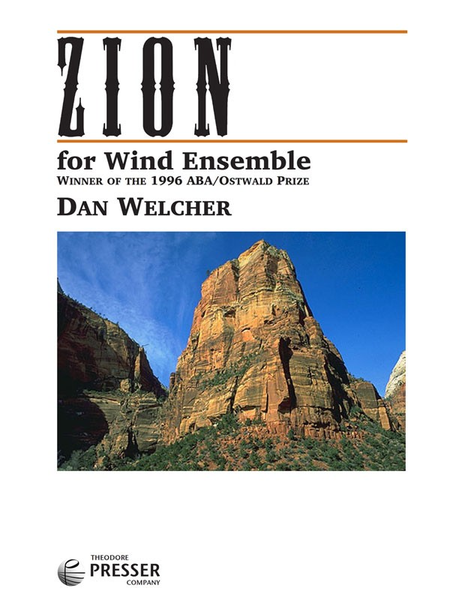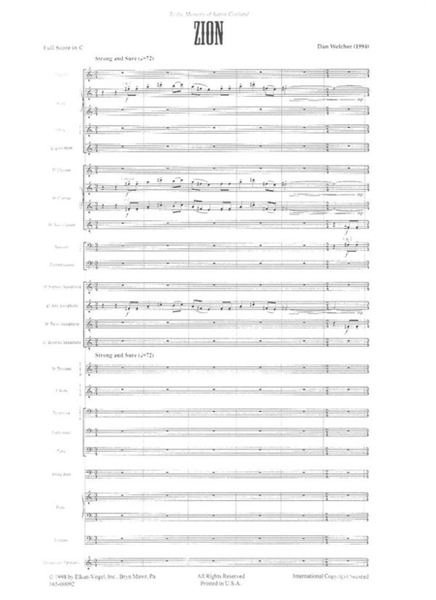Zion
-
Ships in 1 to 2 weeks
Details
Description
SKU: PR.16500092F
Composed by Dan Welcher. Sws. Full Score. With Standard notation. 76 pages. Duration 10 minutes. Theodore Presser Company #165-00092F. Published by Theodore Presser Company (PR.16500092F).ISBN 9781491100905. UPC: 680160039524. 9 x 12 inches.
Zion is the third and final installment of a series of works for Wind Ensemble inspired by national parks in the western United States, collectively called, "Three Places in the West." This work for wind ensemble is full of resolve, glowing optimism, and ends with a sense of triumph and an unbreakable spirit.
Zion is the third and final installment of a series of works for Wind Ensemble inspired by national parks in the western United States, collectively called “Three Places in the West.” As in the other two works (The Yellowstone Fires and Arches), it is my intention to convey more an impression of the feelings I’ve had in Zion National Park in Utah than an attempt at pictorial description. Zion is a place with unrivalled natural grandeur, being a sort of huge box canyon in which the traveler is constantly overwhelmed by towering rock walls on every side of him — but it is also a place with a human history, having been inhabited by several tribes of native Americans before the arrival of the Mormon settlers in the mid-19th century. By the time the Mormons reached Utah, they had been driven all the way from New York State through Ohio and, with tragic losses, through Missouri. They saw Utah in general as “a place nobody wanted,” but they were nonetheless determined to keep it to themselves. Although Zion Canyon was never a “Mormon Stronghold,” the people who reached it and claimed it (and gave it its present name) had been through extreme trials.It is the religious fervor of these persecuted people that I was able to draw upon in creating Zion as a piece of music. There are two quoted hymns in the work: Zion’s Walls (which Aaron Copland adapted to his own purposes in both is Old American Songs and the opera The Tender Land) and Zion’s Security, which I found in the same volume in which Copland found Zion’s Walls — that inexhaustible storehouse of 19th-century hymnody called The Sacred Harp.My work opens with a three-verse setting of Zion’s Security, a stern tune in F-sharp minor which is full of resolve. (The words of this hymn are resolute and strong, rallying the faithful to be firm, and describing the “city of our God” they hope to establish). This melody alternates with a fanfare tune, whose origins will be revealed in later music, until the second half of the piece begins: a driving rhythmic ostinato based on a 3/4-4/4 alternating meter scheme. This pauses at its height to restate Zion’s Security one more time, in a rather obscure setting surrounded by freely shifting patterns in the flutes, clarinets, and percussion — until the sun warms the ground sufficiently for the second hymn to appear. Zion’s Walls is set in 7/8, unlike Copland’s 9/8-6/8 meters (the original is quite strange, and doesn’t really fit any constant meter), and is introduced by a warm horn solo. The two hymns vie for attention from here to the end of the piece, with the glowingly optimistic Zion’s Walls finally achieving prominence. The work ends with a sense of triumph and unbreakable spirit.Zion was commissioned in 1994 by the wind ensembles of the University of Texas at Arlington, the University of Texas at Austin, and the University of Oklahoma. It is dedicated to the memory of Aaron Copland.


 Share
Share